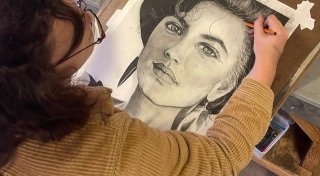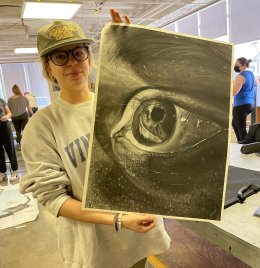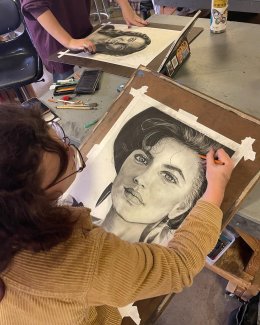
Art and Art History Foundations
[ Above, artist Shelby Weeks, Portrait Project ]
Two foundation courses need to be taken by Art & Art History students, Drawing 1, AAH131, and Survey of Art, AAH116 or AAH117.
Drawing and Art Survey classes serve as cornerstones that equip students not only with technical skills but also with a broader understanding of art's historical, cultural, and social significance, preparing them for further exploration and specialization within the world of art and beyond.
Below you can read more about why these two classes are significant as foundation courses for our major and why drawing is a prerequisite for our studio classes. You might also want to read about the Art & Art History department's Learning Goals.
Drawing
NOTE: Students must take Drawing 1, AAH131, as a prerequisite to all studio courses and is required for the Art & Art History major.
NOTE: Art and Art History foundations, and all Studio Art courses, require Drawing One, an entry level course, to be taken first. However, the class does not assume prior Drawing experience and does not require any previous experience in drawing.
AAH131. Drawing I
This course is the prerequisite for all upper-level studio art courses. Potential majors and minors should take Drawing I as early as possible in their academic careers. The emphasis is on the development of perceptual, compositional, and critical drawing skills. Direct observation of still-life and figurative subjects lead to more abstract modes of expression. Various media are used. Offered every semester.
Drawing serves as a foundational skill in art for several reasons:
- Observation: Drawing trains artists to observe the world more keenly. It helps in understanding forms, shapes, proportions, and details, which are crucial in accurately representing subjects.
- Communication: Drawing is a universal language in the art world. It allows artists to convey ideas, emotions, and messages visually. Whether through sketches, diagrams, or detailed illustrations, drawing serves as a primary mode of communication.
- Skill Development: It hones various skills such as hand-eye coordination, control, and dexterity. These skills are transferable across different art mediums and are essential for an artist's overall development.
- Understanding Composition: Drawing helps in understanding composition, balance, and spatial relationships. Learning how to arrange elements within a space is crucial not only in drawing but also in other art forms like painting and sculpture.
- Exploration and Experimentation: Drawing allows artists to experiment freely. It serves as a platform to explore different techniques, styles, and mediums without the constraints that might come with other art forms.
- Foundation for Other Art Forms: Many other art forms, such as painting, sculpture, and digital art, are built upon drawing skills. Understanding drawing principles makes it easier to transition to these other forms of artistic expression.
- Problem-Solving: Drawing challenges artists to solve visual problems. Whether it's figuring out how to represent light and shadow or how to create depth on a two-dimensional surface, drawing encourages problem-solving skills.
Overall, drawing acts as a fundamental skill that not only helps artists in creating visual representations but also in developing a deeper understanding of art and its various aspects.
Art History Survey
NOTE: Students must take Survey Art Part 1 or Survey of Art Part 2 as a foundational course for the Art & Art History major. It is highly recommended that students take one of these classes before taking advanced art history courses.
AAH116. Survey of Art History, Part I.
A survey of the historical development of art forms from Paleolithic times to the late Middle Ages. Emphasis is placed upon the relationship between the formal aspects of art and the political and social history of a culture.
AAH117. Survey of Art History, Part II.
A survey of the historical development of art forms from the Renaissance to the present. Emphasis is placed upon the relationship between the formal aspects of art and the political and social history of a culture. Also offered through European Studies.
Art History survey classes play a pivotal role in providing a comprehensive overview of artistic movements, styles, and key figures throughout history. Here are some reasons why these classes hold significance:
- Historical Context: They offer a chronological exploration of art history, allowing students to understand how artistic movements evolved over time and were influenced by societal, cultural, and historical contexts.
- Exposure to Diversity: Art History survey courses introduce students to a wide range of artistic styles, traditions, and techniques from various cultures and regions worldwide, fostering an appreciation for global artistic diversity.
- Understanding Influences: They highlight the interconnectedness of art movements and how artists were influenced by their predecessors, contemporaries, and the cultural milieu, providing insights into the evolution of artistic ideas.
- Critical Analysis: These classes encourage critical thinking and analytical skills by examining artworks in depth, teaching students how to interpret, critique, and contextualize art within broader historical and cultural frameworks.
- Foundation for Specialization: They serve as a foundation for students planning to specialize in art history, studio art, or related fields by offering a broad knowledge base that can guide further exploration and specialization.
- Cultural Appreciation: Art History survey classes foster cultural appreciation by showcasing diverse artistic expressions, helping students understand and respect different aesthetic traditions and viewpoints.
- Inspiration and Influence: Exposure to a wide array of artistic styles and movements can inspire students' own artistic endeavors, providing a rich tapestry of influences to draw from in their creative pursuits.
Overall, Art History survey classes provide a holistic understanding of art's evolution, its cultural significance, and its impact on society. They offer a comprehensive foundation that informs and enriches students' perspectives within the realm of art and beyond.
Foundational Studies
See Art And Art History Learning Spaces for a photo gallery tour of all our facilities.


